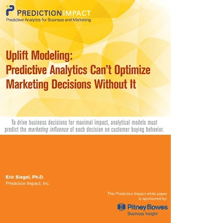
Thank you for your interest in the white paper, “Uplift Modeling: Predictive Analytics Can’t Optimize Marketing Decisions Without It,” written by PAW Founder Eric Siegel, Ph.D., and sponsored by Pitney Bowes Business Insight.
Access the white paper below:
Download this PDF
PDF Download is restricted to site members.
Log in on the right OR subscribe for free
To drive business decisions for maximal impact, analytical models must predict the marketing influence of each decision on customer buying behavior. Uplift modeling provides the means to do this, improving upon conventional response and churn models that introduce significant risk by optimizing for the wrong thing. This shift is fundamental to empirically driven decision making. This convention-altering white paper reveals the why and how, and delivers case study results that multiply the ROI of predictive analytics by factors up to 11.
For upcoming presentations on uplift modeling at Predictive Analytics World, and other additional related resources, see this article.
For a broader introduction to uplift modeling, see also the final chapter of Eric Siegel’s book, Predictive Analytics.
You must be logged in to post a comment.
The Machine Learning Times © 2025 • 1221 State Street • Suite 12, 91940 •
Santa Barbara, CA 93190
Produced by: Rising Media & Prediction Impact


The quality and quantity of work produced in here is absolute informative slime rancher 2
This white paper presents a compelling case for uplift modeling as a critical tool in driving effective business decisions. By focusing on the actual impact of marketing efforts on customer behavior, it addresses the shortcomings of traditional response and churn models that often misguide strategies. The insights and methodologies shared here can empower organizations to make data-driven choices that truly enhance customer engagement and ROI. The case studies illustrating up to an 11-fold increase in ROI provide powerful evidence of the model’s effectiveness. This shift towards uplift modeling could redefine how businesses approach their marketing strategies, ensuring they optimize for real influence rather than perceived metrics. Excited to see how this approach can transform our understanding of customer dynamics! nystateofhealth